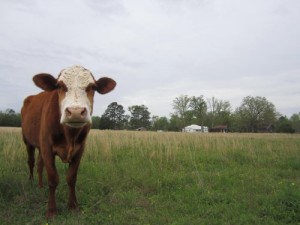Why We Need a More Resilient Food System
Growing food is unique to most other things we “create” as a society. Although at times we may think we have it down to a science, every so often we’re reminded that agriculture depends on natural systems — such as weather and the availability of natural resources (air, water, soil) as well as “inputs” (fertilizer, feed) whose health themselves depend on other factors beyond our control.
The drought that struck the United States this year is a stark example. According to the USDA Economic Research Service, about 80% of agricultural land in the United States is experiencing drought, which makes this the worst in America’s history since the 1950s. Experts believe the drought is a result of rising global temperatures that increase evaporation and effect sensitive atmospheric systems. As the Environmental Protection Agency explains in its Students’ Guide to Climate Change, that moisture shows up more than usual in some places, and less in others – this year, 80% of agricultural land in the U.S. are experiencing the latter.

- Pasture-based beef operations, such as Harris-Robinette Farm in North Carolina, are less sensitive to fluctuations in grain prices than confinement operations
Sad as that is for those Midwestern farmers, what does this have to do with you, perhaps a student on the West Coast or a city dweller in the Southeast? Not much yet, but the changes are coming. Corn and soy are the hardest hit. Not the “sweet corn” you find in winter corn chowder or that you grill in your backyard in the summer, but “field corn” and soy, which are primarily used as animal feed.
In fact, a recent purchasing report from a major food purchasing group said: “A devastating global food crisis unlike anything we have seen in decades is coming. The truth is that we are not just facing rumors of a global food crisis [it] is actually starting to unfold right in front of our eyes… 2013 is currently expected to mark only the second time in 38 years where annual beef, pork, and chicken output all decline. Meat will therefore be increasingly viewed as an indulgence around a year from now.”
We need a resilient food system that can cope with a changing climate and unpredictable conditions such as this drought. How are we going to get there? Assuming we aren’t holding our breath for federal agricultural policy that will motivate change, then companies of all shapes and sizes need to get creative about what kind of a food system they are supporting. And that starts with the people who make up those companies, buy food from those companies, or support those companies in any way, shape or form. When it comes to food, EVERYONE plays a role.
It won’t be easy or simple. In practice, it’s already proven to be quite difficult and complicated, but I’m proud that Bon Appétit is leading the way. We’ve tried to create resilience in obvious ways, by supporting small, local farms directly (creating a diverse and therefore more secure food supply) since 1999 with our Farm to Fork program. But we do it in many other ways. Through our Low Carbon Diet program, by reducing the amount of beef and cheese that we buy altogether, and making sure what we do buy is humanely raised, ideally locally on pasture, and also through our animal welfare purchasing policies, which affect not only the quality of life for animals but have ramifications for nearby soil quality, waterways, and air.
The benefits of a better food system are hard to quantify but impossible to deny. We can no longer afford to turn a blind eye to the fact that all the foods — meat, fruits, snacks, even sodas — we buy at supermarkets, eat at restaurants, and serve in college dining halls are the products of natural systems. Now is the time to strengthen those systems, create local and regional food sheds, better understand what farmers are dealing with, and support them: especially those that are good stewards of their land … and all our shared resources.